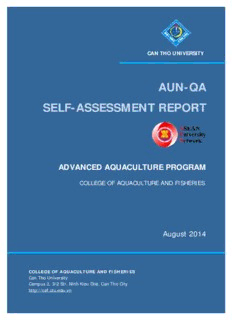Table Of ContentAUN-QA Self-Assessment Report of Advanced Aquaculture Program
CAN THO UNIVERSITY
AUN-QA
SELF-ASSESSMENT REPORT
ADVANCED AQUACULTURE PROGRAM
COLLEGE OF AQUACULTURE AND FISHERIES
August 2014
COLLEGE OF AQUACULTURE AND FISHERIES
Can Tho University
Campus 2, 3/2 Str. Ninh Kieu Dist. Can Tho City
http://caf.ctu.edu.vn
AUN-QA Self-Assessment Report of Advanced Aquaculture Program
LIST OF ABBREVIATIONS
AAP Advanced Aquaculture Program
CAF College of Aquaculture and Fisheries
CTU Can Tho University
AU Auburn University
IQA Internal Quality Assurance
ELO Expected Learning Outcomes
LRC Learning Resource Center
MOET Ministry of Education and Training
QATC Quality Assurance and Testing Center
MD Mekong Delta
1
AUN-QA Self-Assessment Report of Advanced Aquaculture Program
2
AUN-QA Self-Assessment Report of Advanced Aquaculture Program
Table of Contents
---o0o---
I. INTRODUCTION .................................................................................................................. 5
II. AUN-QA CRITERIA AT PROGRAM LEVEL .......................................................... 11
1. Expected Learning Outcomes ............................................................................................... 11
2. Program Specification ........................................................................................................... 15
3. Program Structure and Content (PSC) .................................................................................. 24
4. Teaching and Learning Strategy (TLS) ................................................................................. 29
5. Students Assessment (SA) .................................................................................................... 33
6. Staff Quality .......................................................................................................................... 37
7. Support Staff Quality ............................................................................................................ 45
8. Student Quality ...................................................................................................................... 47
9. Student Advice and Support .................................................................................................. 49
10. Facilities and Infrastructure ................................................................................................. 51
11. Quality Assurance of Teaching and Learning Process........................................................ 56
12. Staff Development Activities .............................................................................................. 59
13. Stakeholders Feedback ........................................................................................................ 61
14. Output .................................................................................................................................. 63
15. Stakeholders Satisfaction .................................................................................................... 77
III. STRENGTHS AND WEAKNESSES ANALYSIS .................................................... 84
1. Strengths ................................................................................................................................ 84
2. Weaknesses ........................................................................................................................... 86
3. Self-assessment at Program Level......................................................................................... 88
4. Plans for Improvement .......................................................................................................... 92
IV. APPENDICES .................................................................................................................... 94
1. List of Tables and Figures ..................................................................................................... 94
2. List of Evidence .................................................................................................................... 96
3
AUN-QA Self-Assessment Report of Advanced Aquaculture Program
4
AUN-QA Self-Assessment Report of Advanced Aquaculture Program
I. INTRODUCTION
1. Can Tho University (CTU)
Established in 1966, Can Tho University (CTU) is a key public higher education institution
and a cultural, scientific and technical center of the Mekong Delta (MD) and Vietnam with
about 48,315 undergraduate students, 2,958 Master students, and 226 PhD students. CTU has
2,042 staff including 1,194 teaching staff and 848 support staff. CTU is a multidisciplinary
university which has been training variety of fields related to agriculture, aquaculture,
technology, environment, law, basic science,…that meet requirement of social economic
development of the Mekong Delta and the country. Currently, CTU offers 92 undergraduate
training programs (including 02 college level programs), 31 Master and 13 Doctoral training
programs. In addition, CTU also offers a short training specifically on tropical issues for
students over the world. Every year CTU receives students on internship programs from the
US, Belgium, Japan, Thailand,…under agreements between their universities and CTU.
Figure 1: The structure of CTU and units
5
AUN-QA Self-Assessment Report of Advanced Aquaculture Program
1.1. Vision of the university
CTU targets to be one of leading higher education institutions in Vietnam and recognized as
one of the top universities in Asia-Pacific in training and research in 2022.
1.2. Mission of the university
CTU operates its resources to be the leading national institution for education, research and
technology transfer making significant contributions to the development of high quality
human resources, fostering the talents and the advancement of science and technology to cater
for the regional and national socio-economic development. CTU is the crucial driving force
for the development of the Mekong Delta region.
2. College of Aquaculture and Fisheries (CAF)
After 25 years being subjected to a number of organizational changes, the College of
Aquaculture and Fisheries (CAF) has been re-established in April 2002. This was to meet an
increasing demand of aquaculture and fisheries services in the Mekong Delta.
2.1. Vision of CAF
CAF with its good capacities will become a strong college to support CTU’s and national
strategic plans to 2030 in aquaculture and fisheries.
2.2. Mission of CAF
The generally major mandates of the College of Aquaculture and Fisheries are:
- Offering undergraduate and graduate educational programs in the fields of aquaculture
and fisheries.
- Conducting researches related to aquaculture development, aquatic environment, fisheries
resource management, and marine biodiversity.
- Transferring technologies of aquaculture and fisheries to farmers and the commercial
production sectors in the Mekong delta and related regions.
2.3. Activities
Training activities
CAF offers educational programs leading to a number of different degrees within various
fields and levels:
- Bachelor of Science in Aquaculture (taught in Vietnamese), Bachelor of Science in
Aquaculture (taught in English), Marine culture and conservation, Aquatic resources
Management, Fish Pathology, Fisheries product processing, Fisheries economics.
- Master of science in Aquaculture and Aquatic resources Management
- Ph.D. in Aquaculture
CAF is conducting researches in a wide range of subjects such as (i) nutrition and feeds,
reproduction, aquatic animal health, and physiology; (ii) culture techniques of different
6
Description:have investigated the environmental ecology features and likely solutions to
utilize environmental studies, fisheries resource management, economics, fish
.. presentations, quizzes, midterm and final exams. Grading structures vary by

